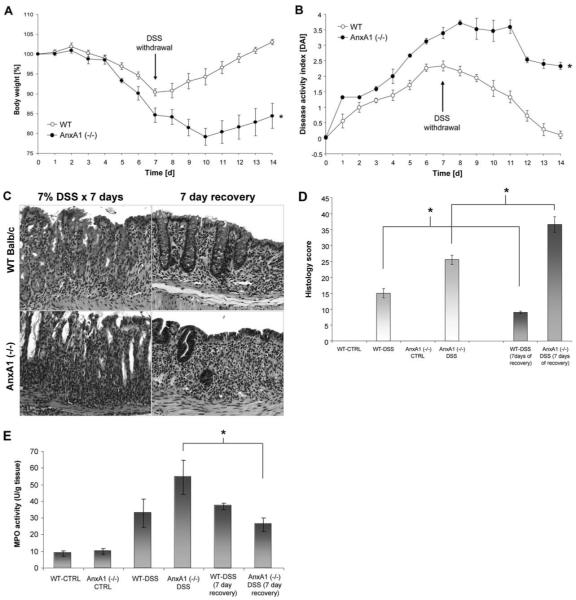FIGURE 5.
AnxA1-deficient mice exhibit impaired clinical and histopathologic improvement following withdrawal of DSS treatment. AnxA1 (−/−) mice exhibited a significant reduction in the rate of weight gain following withdrawal of DSS treatment compared with WT controls (A; *, p-value <0.05, n = 7 mice). Similarly, AnxA1 (−/−) animals showed an impairment in recovery following DSS withdrawal as determined by DAI (B; *, p-value <0.05, n = 7 mice). Representative photomicrographs of H&E-stained histologic sections (C) demonstrate more severe histopathologic injury following 7 days of DSS treatment in AnxA1 (−/−) animals compared with WT controls. After 7 days of recovery, WT animals appeared to exhibit slightly less epithelial injury and reduced inflammation. However, a mild degree of architectural irregularity as evidenced by minor irregular crypt spacing was identified. In contrast, while the inflammation in AnxA1 (−/−) animals was improved to a small extent following 7 days of recovery from DSS-induced colitis, significantly increased epithelial injury with the development of architectural irregularity was observed (C). Histologic scoring (D) of colonic injury revealed some improvement of histopathologic changes in WT animals, whereas an overall increase in injury was found in AnxA1 (−/−) animals (*, p-value <0.05, n = 7 mice). Measurement of MPO activity (E) did not reveal a statistically significant difference in leukocyte infiltration in WT animals between 7 days of DSS treatment and after 7 days of recovery. MPO activity in AnxA1-deficient animals improved to a degree similar to that of WT controls at day 7 of DSS treatment and was less than that of WT controls following a 7 day recovery period (*, p-value <0.05, n = 7 mice).

